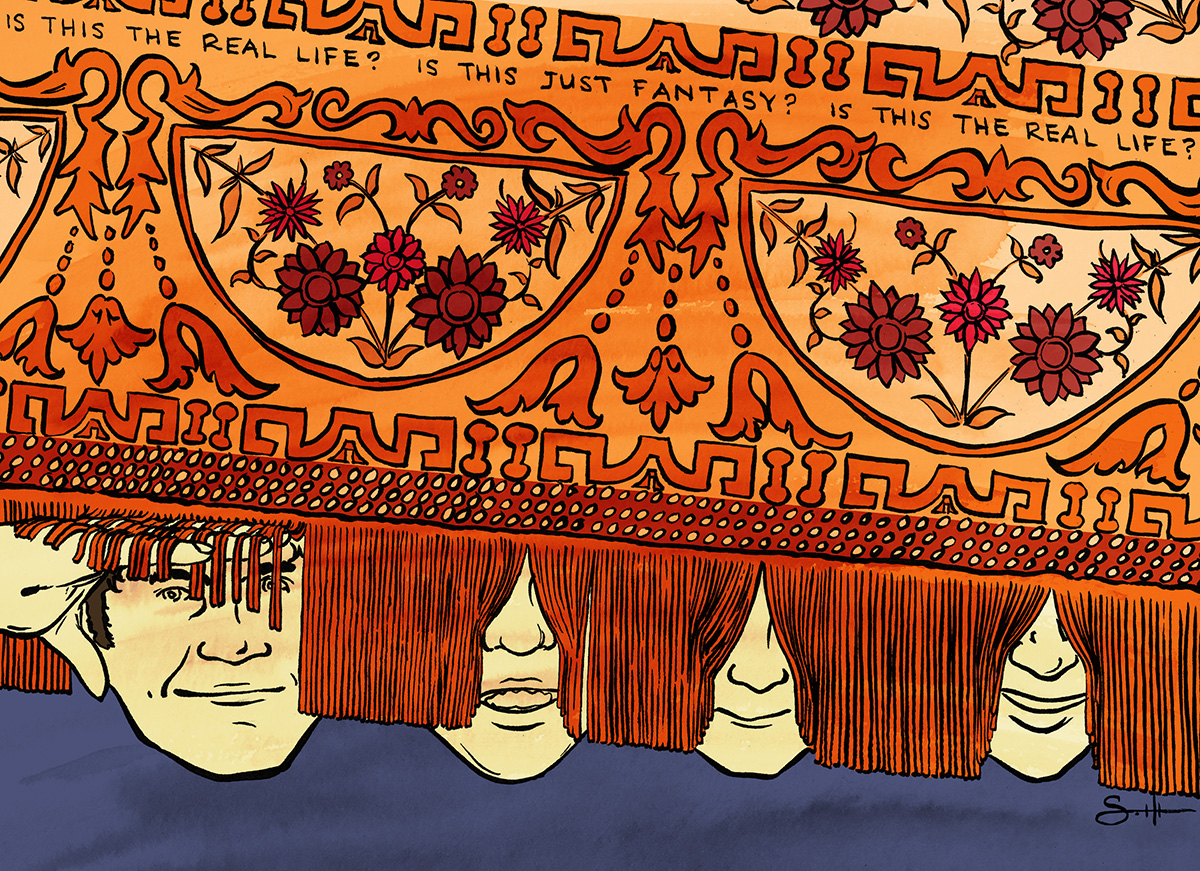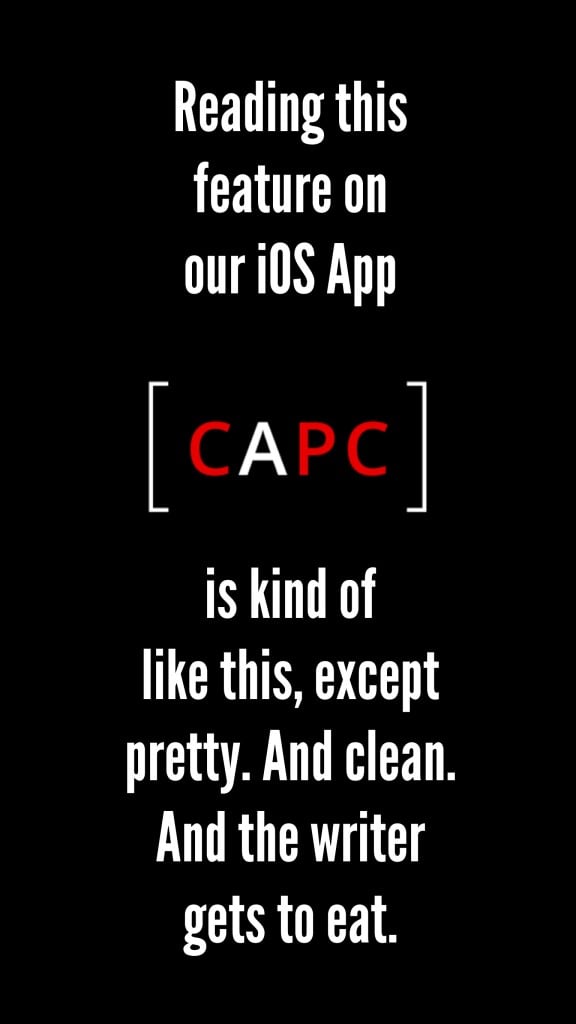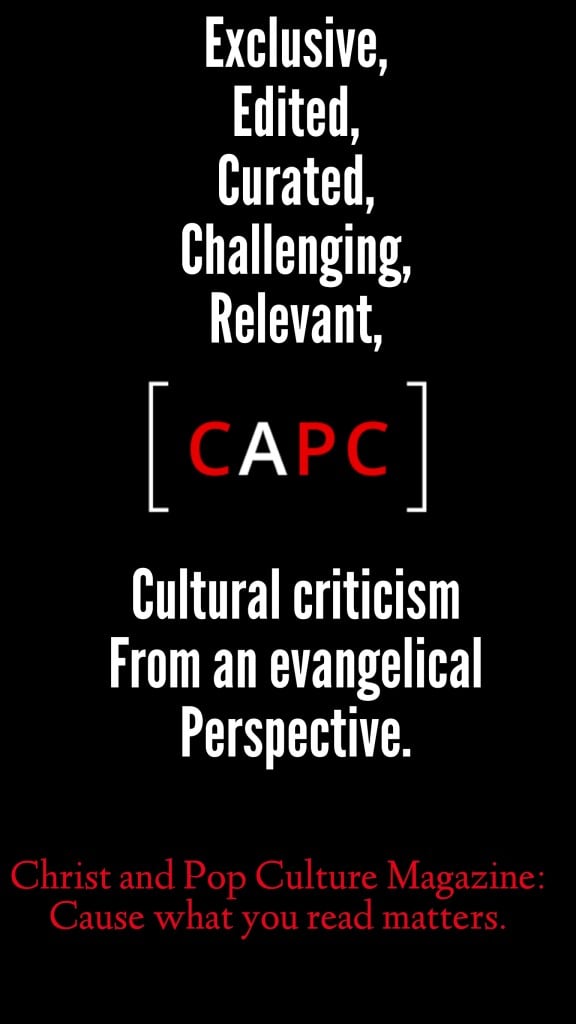
By Gregory Alan Thornbury, Ph.D.
The following is an exclusive feature that has been shared with you but is otherwise available only in Issue #20 of the Christ and Pop Culture Magazine.
For more features like this, download our app for iPad and iPhone from Apple’s App Store.
After a one-week free trial, monthly and yearly subscriptions are available for $2.99 and $29.99 respectively. New issues are made available every other week. More information here.

Long before Kanye or Miley’s respective episodes in reality testing, a fascinating episode in blurring the lines between image and reality lit up television screens on Monday, September 12, 1966 at 7:30 p.m. EST with The Monkees. In 1962, aspiring filmmaker Bob Rafelson got the idea for a television show about an American rock and roll band, but the concept didn’t gain traction until after The Beatles made A Hard Day’s Night. Picked up by NBC in 1965, Rafelson and co-producer Bert Schneider began casting for the show. They ran an ad in Variety for actors for the series looking for “insane Bert Frank’s” type boys who were “Folk & Roll musicians” for a show about an out-of-work California rock band. The Monkees targeted teen and pre-teen audiences.
Although they already had the British born Broadway star Davy Jones in mind before the series began, the three other members included Mickey Dolenz (a former child TV star), Greenwich Village musician Peter Tork (who was referred to Rafelson and Schneider by Stephen Stills, who failed in his bid to get cast for the show), and Texas-born guitarist and singer/songwriter, Michael Nesmith (incidentally whose mother, Bette Nesmith Graham, invented Liquid Paper – or Wite Out – in her kitchen in 1951).
The program was a trippy mix of threadbare narrative and quirky, old-fashioned physical comedy capped off by a “Monkee Romp” which involved the first music videos – twenty years before the advent of MTV. As John Lennon later observed, the Monkees were the second coming of the Marx Brothers.
 But a funny thing happened on the way to a hit TV show: sales for the record, which was designed to accompany the show, outpaced the Nielsen ratings by a large margin. Although Nesmith had written and performed songs on the first album (with Tork playing in a supporting role), besides the vocals, The Monkees were not a real band. When the first record actually came out, Nesmith was aghast: it gave the appearance that The Monkees were actually a musical foursome, instead of a TV show about a band. There was no credit given to the studio musicians who played on the record.
But a funny thing happened on the way to a hit TV show: sales for the record, which was designed to accompany the show, outpaced the Nielsen ratings by a large margin. Although Nesmith had written and performed songs on the first album (with Tork playing in a supporting role), besides the vocals, The Monkees were not a real band. When the first record actually came out, Nesmith was aghast: it gave the appearance that The Monkees were actually a musical foursome, instead of a TV show about a band. There was no credit given to the studio musicians who played on the record.
“Last Train to Clarksville” went #1 on the pop charts. It was a weird problem to have. Nesmith went ballistic. The producers said, “It’s just a fantasy.” Nesmith told them that there was a definite line between fantasy and reality, and it had been crossed. He was furious that he had been implicitly involved in duping the public. As the French critical theorist Jacques Lacan once admonished his students: “Be wary of the image.”
Dolenz could play guitar, but he had never actually sat behind a drum kit before. The production company Screen Gems told him, “You’re the drummer.” Jones, who could play drums, was cast as the frontman and vocalist for the group because he was supposed to be the teenage heartthrob. Other than a jam or two while filming the show, the foursome had never played as a group. When word got out, there was a lot of righteous indignation in the music press. Despite the fact that The Monkees were originally supposed to be “Hollywood,” Rafelson and Schneider approached the four boys to inform them that they had to go on the road – as an actual touring rock and roll band.
Almost overnight, The Monkees had to become a legitimate rock and roll band, playing in front of thousands of screaming fans every night in sold out stadiums across the country. Dolenz boned up on his drum chops with pros like Hal Blaine and Buddy Miles. He even had to switch legs for the kick drum, due to a childhood leg disease he had called Perthes. They started writing their own songs. So when they charged onstage and plugged in, they were legitimate, a grungy proto-punk version of their on-screen counterparts. In the process, all four Beatles became fans. Dolenz later offered the analogy that it would be like William Shatner and Leonard Nimoy showing up to the set of Star Trek and actually becoming astronauts.
Nesmith demanded that if they were forced to be an actual act, they had to control the music. Screen Gems Music supervisor Don Kirshner was canned (after an incident in which Nesmith famously punched his fist through the wall). Kirshner felt that the idiots were now running the asylum.
 Instead, what followed was actually a pretty incredible artistic run. On the show itself, The Monkees were experimental and format-forward. They broke the fourth wall by talking directly to camera and were constantly reminding the audience that they were just on the set of a TV show. Frank Zappa (dressed as Nesmith) interviewed Nesmith (dressed as Zappa), and talked about The Mothers of Invention. In the studio, The Monkees had creative control, gaining the ability to write, perform, and produce their own material without a noticeable drop off in quality from the previous record(s).
Instead, what followed was actually a pretty incredible artistic run. On the show itself, The Monkees were experimental and format-forward. They broke the fourth wall by talking directly to camera and were constantly reminding the audience that they were just on the set of a TV show. Frank Zappa (dressed as Nesmith) interviewed Nesmith (dressed as Zappa), and talked about The Mothers of Invention. In the studio, The Monkees had creative control, gaining the ability to write, perform, and produce their own material without a noticeable drop off in quality from the previous record(s).
Among other things, for example, the recordings signaled the beginning of the Country-Rock format (via Nesmith) years before The Flying Burrito Brothers or The Eagles hit the L.A. scene. The album Headquarters included tracks like “Randy Scouse Git” (written by Dolenz), which later became heralded as one of the most critically acclaimed singles of the 60’s. Incredibly, they also gave Harry Nilsson his first break as a songwriter. After the series was cancelled, they went on to release an avant-garde film called Head, co-written and co-produced by a then obscure actor named Jack Nicholson. And to show that references to the artful Monkees still abound, this past season of Mad Men ended with the soundtrack outro of “The Porpoise Song” from Head.
As a kid sitting in front of the television watching The Monkees in syndication, years after the show ended, I was dazzled by all of this. My parents, who were on the record that they didn’t want me listening to rock and roll, didn’t seem to mind The Monkees. I mean, hey, it was a kid’s TV show, right? [Sidebar: I always felt there was a double standard at home. My Dad had a stack of Elvis, Johnny Cash, Jerry Reed, and Marty Robbins LPs, but that’s a story for another time!]
 Somehow, knowing The Monkees backstory, I was sort of impressed at how they just somehow magically became legitimate rockers. Sure they were backed by NBC, but I find it interesting that something which began artificially – as just an image – became the real thing. As I got older, and started to play guitar, I still loved the way Nesmith’s and Tork’s guitars sounded, trebly and sparkly, both Hippie and Honky Tonk. And then, in high school, all of a sudden MTV started running the old TV episodes, and a Monkees revival was fully underway by 1986. As dumb as this sounds, it strangely felt to me like vindication.
Somehow, knowing The Monkees backstory, I was sort of impressed at how they just somehow magically became legitimate rockers. Sure they were backed by NBC, but I find it interesting that something which began artificially – as just an image – became the real thing. As I got older, and started to play guitar, I still loved the way Nesmith’s and Tork’s guitars sounded, trebly and sparkly, both Hippie and Honky Tonk. And then, in high school, all of a sudden MTV started running the old TV episodes, and a Monkees revival was fully underway by 1986. As dumb as this sounds, it strangely felt to me like vindication.
The lines between fantasy and reality blurred even further for me when Davy Jones bought a horse farm in Beaver Falls, Pennsylvania, near my home town. I would see him at the mall and at the movies. And no, I never got up the gumption to talk to him beyond, “Hey, Davy!”
Even in college, when I was studying philosophy and communications theory, I continued to be fascinated by The Monkees. I loved how they won in a war of wills with Kirshner and co-opted corporate America to serve their artistic vision. They became anti-heroes to me. Although I kind of lost interest in The Monkees over the years, I did remain an active Michael Nesmith fan, who went on to be a Grammy award winning video pioneer, musician, novelist, and cult film producer.
In his 2009 novel, The American Gene, Nesmith wrote that everyone in life has what he calls a PLV (i.e. Personal Las Vegas moment). It’s the moment where you must choose between what is easy over what is hard — the manufactured image over the difficult work of reinventing oneself. It’s Elvis going to Vegas instead of breaking new ground in the studio by exploring his roots from the Mississippi Delta. Elvis became a parody of himself. Your PLV moment is a war between image and substance. It’s a war for control. It’s that moment of self-examination about one’s existential situation that results after reading Walker Percy’s Lost in the Cosmos: The Last Self Help Book. Will you be who you really are? Or will you give into the image, to what the world wants you to be?
 As a kid watching The Monkees, I found it pretty amazing that a fantasy TV show became a reality show. Although they had musical ability, Davy, Mickey, Peter, and Mike were hired to be actors playing musicians. The origins of the Greek word for “hypocrite,” of course, refer to the profession of the actor. But the word itself eventually came to denote something negative – that of being a pretender and a phony. In The Sermon on the Mount, Jesus said that people who are content with an image and not being the real thing “have their own reward.” (Mt. 6:5). The Monkees refused to be a pre-fabricated boy band, owned and sold by NBC. The image lost significance if they couldn’t be themselves.
As a kid watching The Monkees, I found it pretty amazing that a fantasy TV show became a reality show. Although they had musical ability, Davy, Mickey, Peter, and Mike were hired to be actors playing musicians. The origins of the Greek word for “hypocrite,” of course, refer to the profession of the actor. But the word itself eventually came to denote something negative – that of being a pretender and a phony. In The Sermon on the Mount, Jesus said that people who are content with an image and not being the real thing “have their own reward.” (Mt. 6:5). The Monkees refused to be a pre-fabricated boy band, owned and sold by NBC. The image lost significance if they couldn’t be themselves.
To me, that psychedelic, subversive kids TV show from the 1960’s felt like something more epic. As I grew older, it served as a metaphor for what Tolkien spoke of when he wrote “Mythopoeia” for the benefit of his then-skeptical friend C.S. Lewis: “The heart of Man is not compound of lies, but draws some wisdom from the only Wise, and still recalls him.” Fairy stories, and even make-believe-turned-real rock and roll bands, remind us that we long for the most fantastic of our stories to point to something greater, something really true – an über-myth. Again, as Tolkien explained, our best stories strive to transcend:
Yes! ‘wish-fulfilment dreams’ we spin to cheat
our timid hearts and ugly Fact defeat!
Whence came the wish, and whence the power to dream,
or some things fair and others ugly deem?
All wishes are not idle, nor in vain
Sitting in front of that TV, the fact that The Monkees escaped small screens and scripts to play for the first time in public as a band before thousands of screaming fans on December 3, 1966 at the Honolulu International Centre Arena somehow reassured me. In hindsight, it pointed dimly to those same verities about which Tolkien wrote to an unconverted Lewis. To be certain, Lewis was right when he challenged Tolkien with the fact that Christianity was, in a sense, not unique. Ancient Near-Eastern literature was filled with dying-and-risen-to-new life deities. But Tolkien knew the greater truth: the Gospel of Jesus Christ had a unique advantage: it was the myth that actually happened in time and space.
This past week, I went to MOMA to see the exhibition on Rene Magritte before it closed. None of these surrealist works holds as much significance to the history of philosophy as does the painting Ceci n’est pas une pipe (“This is not a Pipe”). Michel Foucault found the work to mean once-for-all death of the notion that the realistic representation of ideas is possible. For Foucault, imagination is all that is left in this absence. Although this is not the place fully to engage either French philosophies or surrealist painters, I will say this: to a child whose nose is in a fantasy story or comic book, or who watches guitar heroes on after school TV, it’s wonderful to suspend disbelief and to dream that there’s real substance behind the image.
Gregory Alan Thornbury, Ph.D., is the President of The King’s College in New York City.
Illustration courtesy of Seth T. Hahne. Check out Seth’s graphic novel and comic review site, Good Ok Bad.